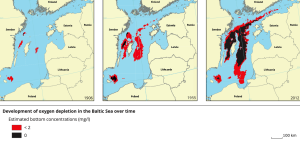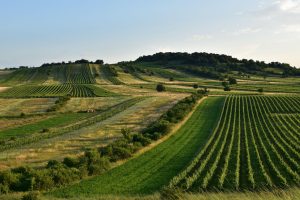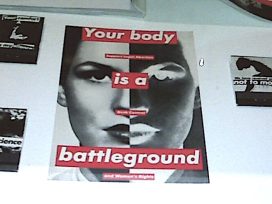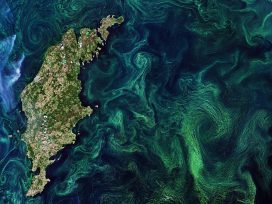Öland is an ancient island located off the Swedish coast. Protected by UNESCO, it has been home to humans for about 5,000 years and hosts archeological sites dating back to the prehistoric period. As per the islanders’ custom, Öland has preserved its agricultural landscape and traditions dating as far back as the Iron Age and has, unsurprisingly, become a desirable tourist destination, offering its visitors everything from horseback riding tours, sights of old wooden mills and, of course, an opportunity to swim along its sandy beaches.
The latter opportunity, however, is becoming more uncertain: the idyllic coastal waters of Öland are periodically covered by “the rhubarb-curd-like and toxic sludge” or, as it is more commonly and politely called, algal bloom. Algal blooms are ugly, stinky, and rapidly diminish any enthusiasm to go into the water – or even to stay on the beach. But that is not all: marine biologists warn that these blooms may contain a microorganism named cyanobacteria. The problem they pose is not merely that of aesthetics or an olfactory offence: they can be poisonous, particularly to children and dogs.

Algae bloom around Gotland, Sweden. Source: https://www.esa.int/ESA_Multimedia/Images/2019/12/Baltic_blooms
Such algal blooms thus can have a detrimental impact on local tourism and economies – and this impact is not limited to Öland alone. Surveys conducted in Sweden have shown local businesses reporting a decrease in bookings due to the algal blooms around Gotland island. In 2005, on Öland itself, it was estimated that algal blooms resulted in losses of approximately 11 million EUR for the tourism and fishing sectors. Sometimes, local municipalities endeavour to organize clean-up efforts. These can be rather costly as well: the municipality of Strömstad (Skagerrak) estimates the cost of such clean-ups at 70,000 EUR per year. Across the Baltic from Öland, researchers of Lithuania’s Marine Research Institute warn that unless we take action, coastal waters will become unsuitable for swimming altogether.
Take action against what, and how? There are multiple processes contributing to the proliferation of stinky and sticky algae in a specific location. One of the major causes in the Baltic Sea is a process ornately named eutrophication, likely originating from the Greek term eutrophos, or well-nourished. While the origins of the term might sound wholesome, the process of eutrophication as it is now in the Baltic Sea is anything but: it refers to vast, oxygen deprived seawater areas, alternately named “dead zones”.
These dead zones occur when excess nutrients – such as nitrates or phosphorus widely used in intensive agricultural production – reach the sea via groundwater, atmosphere, but mostly rivers. These excess nutrients provide food for certain algae and bacteria, which eventually forms a surface layer blocking sunlight to deeper waters and providing food for oxygen-consuming bacteria. These processes create areas where very little to no oxygen is available, and thus little to no other oxygen-consuming life can survive.

Source: Map 4.2 CCIV 71127_Development of oxygen-depletion.eps | European Environment Agency’s home page
It is thus unsurprising that the Baltic Sea Centre (BSC) at Stockholm University calls eutrophication the most serious environmental problem the sea faces today. Its consequences reach far beyond the damage caused to coastal tourism sites: eutrophication negatively affects not only humans, but also the marine animal world. Along the Finish coast, for instance, eutrophication-induced oxygen depletion and loss of water clarity is linked to the majority of biodiversity loss cases, contributing to the drastic reduction or even disappearance of fish, including zander, flounder, whitefish, and also many types of sea plants. And it is a man-made disaster: scientific estimates show that oxygen levels in the Baltic have reached a 1500-year low, likely due to nutrient run off in the seawater.
The problem has been known for nearly 50 years: the immense negative impact of eutrophication, as well as humanity’s role in the process, was first recognized in the early 1980s. According to the Baltic Marine Environment Protection Commission (HELCOM), an intergovernmental organization and a key platform for environmental policymaking for the protection of the marine environment of the Baltic Sea, input of nitrogen and phosphorus into the Baltic Sea has grown between the 1950s and the late 1980s. Since then, measures were taken and nutrient run-offs have been reduced.
Nutrient inputs may have decreased, yet oxygen depletion stays at about the same level. This is partly determined by the geographic specificities of the Baltic Sea, including the very slow turnover of seawater due to its narrow access to the ocean. Slow water turnover means that, at the moment, we are seeing nutrient loads from 30 years ago. Unlike the frenetic and momentary pressures of globalized markets and excess consumption, including that of agricultural products, the rhythm of the sea is slow. In the most generous assessment, all we have managed to achieve is preventing the situation from getting even worse.
Agriculture for the sea
Melancholy, frustration, hope – this was an unlikely yet unsurprising blend of moods at HELCOM’s seminar “Sustainable agriculture for a healthy Baltic Sea,” which took place in Helsinki last autumn. Participants dwelt on the critical environmental state of the sea, the slowness (or absence) of progress in its protection, the lack of political will and commitment when it comes to the implementation of existing environmental regulations designed to protect the sea, and also the fact that deadlines set for achieving desired environmental indicators will not be met.
It was not by accident that the seminar focused on sustainable agriculture. While the reasons behind devastating eutrophication levels in the Baltic Sea are many, the predominant source of excessive nutrient input and the damage it causes is clear: agricultural activity and, more specifically, intensive use of fertilizers, many of which end up in the sea. It is for this reason that in the latest Baltic Sea Action Plan (HELCOM’s strategic programme of measures for achieving a good environmental status for the sea) the majority of the 36 measures designed to tackle eutrophication were related to agriculture.
Protection of the Baltic Sea and the waters that eventually reach it is pursued by numerous EU directives and regulations. From the ‘Water Framework Directive’, the ‘Nitrates Directive’, to the ‘Marine Strategy Framework Directive’ – all of them aim to protect ground and surface water quality, achieve good environmental status for European waters in general, and for seas and oceans in particular, as well as to limit the nitrogen load caused by agricultural practices.
These directives, however, are not the only policy initiatives that bear impact on the pursuit of complex solutions to a simple objective: reduction of nitrogen and phosphorus runoff to the sea. The objective is inevitably linked to how the EU regulates agricultural production. In its own right, European agricultural policy is hugely impacted by the EU’s Common Agricultural Policy, also commonly known as CAP. CAP is a financial behemoth, absorbing approximately a third of the EU’s common budget (for instance, the 2021-2027 budget is €1.21tn, and CAP accounts for €386.6bn).
It is also one of the oldest surviving European policies, established in the aftermath of the scarcity and insecurity left behind by WWII. At the time it focused on increasing agricultural productivity, ensuring food security and affordability, and sought to grant farmers a decent living. In pursuit of ensuring food security, from the very beginning, CAP engaged in shielding farmers from the instability posed by crop failures or open markets.
CAP’s policies – particularly their farming subsidies schemes – have often been embroiled in controversy, oftentimes over what environmentalists see as encouragement of the formation of large farms and intensive farming techniques, focused on food quantity rather than quality. According to the critics, one of the key problems lies in the way in which subsidies are allocated: based on the number of hectares the farmer owns, rather than on their compliance with environmental or climate objectives.
Distribution of CAP support is also overwhelmingly unequal. The European Environment Agency has estimated that in the period of 2014-2020, 20% of the beneficiaries received 80% of CAP direct payments. This imbalance creates a growing income gap between the largest (and richest) and smallest farms, encouraging farmers to go big or go home.
While large farms do not by definition mean intensive or environmentally unsustainable farming, and payouts for environmentally friendly measures do exist, it appears that they are largely ineffective. When it comes to organic farming, for instance, the latest audit by the European Court of Auditors (ECA) revealed a rather awkward situation: member states applied EU funds inconsistently, and the provision of funds continued regardless of whether growers applied such basic principles of organic farming such as crop rotation or animal-welfare standards.
According to the ECA report, about €12bn of EU funds that were channeled to support organic farming in the past 10 years have not helped to increase production of organically grown food. The target of achieving 25% of organically farmed agricultural land by 2030 is also unlikely to be met. At present, the only EU country meeting this objective is Austria.

Agricultural landscape in the Austrian state of Burgeland, winner of Europe’s 2023 best organic region award.
Photo: Agne Rimkute, 2024.
EU’s sustainable food strategy: dead on arrival
In 2020, the EU raised hopes by launching an ambitious European Green Deal initiative aimed at achieving climate neutrality by 2050. A pivotal part of the Green Deal was a Farm to Fork strategy, designed “to reduce dependency on pesticides and antimicrobials, reduce excess fertilisation, increase organic farming, improve animal welfare, and reverse biodiversity loss.” Within 4 years, these ambitions were lost. How?
One of the problems appears to be the affinity between large farming unions and some of the decisionmakers at the EU level. Significantly, one of the largest European farmers’ unions, Copa-Cogeca, was from the onset opposed to the reforms proposed by the Farm to Fork strategy. Copa-Cogeca, established around the same time as CAP, claims to represent the entirety of 22 million Europeans working in agriculture, thus representing a sizable voice.
However, many small scale farmers disagree. In their view, the union represents industrial, large-scale farming interests rather than those of small or organic farms. Some – like Jean Mathieu Thevenot, a young farmer and a member of the French agricultural union Confédération Paysanne – believe that long-term food security can only be safeguarded by moving away from fertilizer- and pesticide-dependent intensive agriculture. Responding to a “Lighthouse Reports” inquiry, he emphasized that his circle of farmers is completely disconnected from the vision of Copa-Cogeca and rather sees farming practices it advocates for not only as dangerous for food sovereignty, but also as a hindrance for young farmers’ entry into the business.
These perspectives, however, remain sidelined, apparently not without a contribution of considerable lobbying efforts: a telling investigation by DeSmog.org, a climate journalism platform, documented an intensive schedule of meetings that occurred between several stakeholders affected by Green Deal policies, including pesticide and fertilizer producers, farming unions (most frequently Copa-Cogeca), and a handful of influential conservative politicians (all members of the European Peoples’ Party).
And all of this was before the spectacle of farmers’ protests of 2024 erupted – featuring manure dumping on the streets of Prague, border blocks on the Polish-Ukrainian border, setting fire to asbestos along Dutch roads. While the protests ravaged the streets and amused the dwellers of major European capitals, 15 of 31 actions proposed as part of Farm to Fork had not gotten off the ground. Instead, the European Commission’s proposal to reduce pesticide use by 50% by 2030 was shelved. In rapid political retreat, the new EU’s Vision for Agriculture and Food announced by the European Commission in early 2025 no longer prioritized environmental protection.
Lobbying efforts alone do not explain the watering down of Farm to Fork initiatives. It did not help that the European Green Deal and its backbone, the Farm to Fork strategy, were introduced in the midst of multiple unprecedented shocks. The announcement of the global pandemic in 2020 and Russia’s invasion of Ukraine two years later both raised concerns regarding food accessibility and security, not dissimilar to those that shaped CAP at its establishment. Historically, the (almost) unprecedented rise of the far-right in Europe also did not help: they did not hesitate to use farmers’ discontent for their political purposes ahead of the 2024 election cycle.
When asked about what needs to be done to halt and reverse the overwhelming eutrophication of the Baltic Sea, marine researchers, policymakers and activists will frequently point to the food we eat and the ways in which we produce it; to the reduction of fertilizer use and nutrient run-off to groundwater; to the necessity of cutting back the need for fertilizer use by reducing food waste; to the expansion of environmentally friendly and organic farming methods; and to the importance of the reduction of meat consumption (animal agriculture represents 40% of EU’s total agricultural activity). However, these policies, even when undertaken, are at risk of hitting a wall of industrial farming interests, as well as globalized market and geopolitical pressures.
Balancing food security, global supply chains, international competition, fair remuneration to the EU’s farmers, and environmental protection is not supposed to be an easy task, and a return to ancient agricultural practices of the Baltic Öland is unlikely to offer a feasible solution. Yet, agricultural and environmental policies should include a greater representation of diverse types of expertise and interests – including those of the researchers and farmers who are committed to more sustainable agricultural practices, as well as coastal and other local human and animal communities that suffer direct environmental and even economic effects of large-scale industrial agricultural practices. Last but not least, these policies should reflect the viewpoint of European citizens, the majority of whom are open to supporting greener policies.
This article was published under the Come Together journalism fellowship programme organized by Kurziv. The article was originally published by Kurziv.










